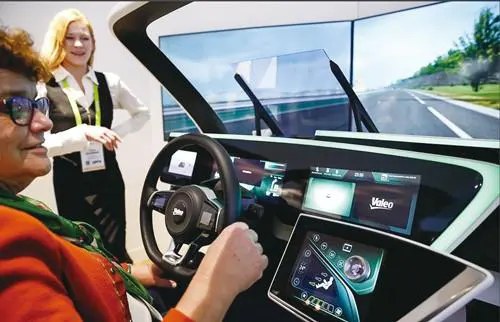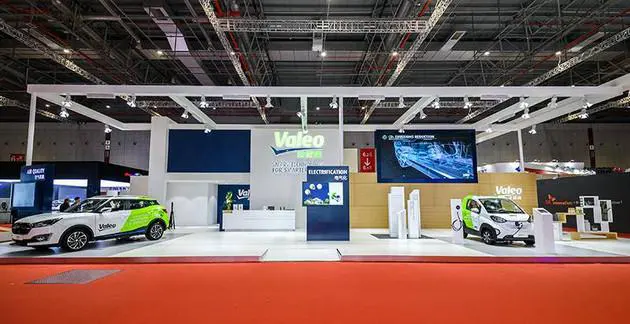

Not only the mileage anxiety, but the battery safety anxiety and life anxiety of new energy vehicles are all related to the thermal management system. As one of the core technologies of new energy vehicles in addition to the "three powers", the thermal management system has become another "arena" for domestic and foreign automakers to compete.

Not only are domestic and foreign vehicle companies such as Tesla, BMW, SAIC, BYD, Weilai, etc., have increased their attention to vehicle-level thermal management in electric models, but also Valeo, Mahler, Continental, and BorgWarner , Rheinmetall and other international parts giants, as well as domestic parts companies such as Huayu Automobile and Sanhua Intelligent Control, are also accelerating their entry into the new energy vehicle thermal management system market.
抢滩热管理系统市场
At the Shanghai Auto Show, Valeo showcased its thermal management system and cabin comfort solutions suitable for multiple scenarios and multiple climates, including an innovative heat pump system that uses refrigerants to convert air energy into power to perform Effective heating, cooling and demisting.

The heat pump in the MAHLE thermal management system can concentrate the heat generated by the batteries, traction motors and power electronics, and upgrade them to heat the cabin. "We have obtained the mass production project of the heat pump, and its first mass production project will be in China." The Chairman and CEO of the MAHLE Group Management Board revealed to the media. MAHLE is also working with Faurecia to develop innovative cockpit thermal management technology.
In BorgWarner's comprehensive thermal management solutions including cockpit and battery heaters, efficient battery heaters have fast response characteristics to achieve the best battery and cockpit temperature management. The high-pressure cabin heater can create a comfortable cabin interior space by virtue of zone heating and core temperature sensing capabilities.
Webasto also integrates the thermal management system in the lower housing, which makes the system more integrated and the thermal management more efficient.
The thermal management system displayed by Continental adopts new technologies such as a new multi-way valve-coolant flow control valve to meet the heating and cooling needs of the vehicle in a more energy-efficient way. The first batch of thermal management systems used in electric vehicles is scheduled to begin mass production in China at the end of 2019.
Heat pump air conditioner to ensure low energy consumption heating
At present, most electric vehicles mainly use electric heaters to raise the temperature, resulting in shortened cruising range and charging cycle. How to deal with changeable and even extreme climatic conditions, while improving the comfort of the car, while ensuring the optimal cruising range, is a problem that must be solved in the development of electric vehicles.
In electric vehicles, batteries and electric drive systems have replaced the engines, and the air-conditioning systems of electric vehicles have undergone great changes compared with traditional automotive air-conditioning systems. The first is the refrigeration mode, where the power source of the refrigerant cycle is provided by the electric compressor; the second is the heating mode, where it is necessary to find a heat source to replace the engine coolant, such as PTC, water heating cycle, etc. From a trend point of view, to ensure low energy consumption heating, heat pump air conditioning is the better solution. Its efficiency coefficient is 2-3 times higher than that of PTC heating, and the cruising range can be increased by more than 20%. Nissan Leaf, Toyota Prius, BMW i3, Volkswagen electric golf and other models have been mass-produced and installed. It is estimated that by 2020, the domestic heat pump penetration rate will reach 10%, and by 2025 it will reach 30%.
The heat pump air conditioning system shares a set of refrigerant circulation system in the cooling and heating modes, and realizes the functions of cooling, heating, dehumidification and other functions through the switching and control of solenoid valves, electronic expansion valves and electric compressors.
At present, international thermal management giants such as Denso, Valeo, Hanon, and Mahler have all launched on-board heat pump air-conditioning systems, and some domestic component companies have also begun to form a supply system. Among them, it is worth mentioning that Huayu Sanden, a subsidiary of Huayu Automobile, has independent intellectual property rights for heat pump air-conditioning system design and core components. Turning on the heating air conditioner in winter can increase the mileage of the vehicle by about 30% compared with the air-conditioning system that uses the high-pressure PTC to provide the heat source. The Roewe Ei5 and MARVEL X equipped with the heat pump air conditioning system still perform well in the winter cruising range when the heater is turned on.
The main cause of spontaneous combustion is battery thermal runaway
The thermal management system of new energy vehicles is mainly composed of four parts: automobile air conditioning system, battery thermal management system, electric motor control cooling system, and reducer cooling system.
With the increase in the on-board power of electric vehicles and the increase in battery energy density, the technical level of the battery thermal management system not only directly affects the performance of the driving range, but also relates to the safety of electric vehicles. The management objects of the thermal management system of new energy vehicles also extend from the cockpit to the fields of battery, motor and electronic control.
According to public opinion information from the State Administration for Market Regulation, there were more than 40 new energy vehicle fires in 2018. The main reason for the spontaneous combustion of electric vehicles is to a large extent because the thermal runaway of electric vehicle batteries turns into heat spreading, which causes accidents. In layman's terms, thermal runaway is the failure of the thermal management system that protects the stability of the battery due to design flaws and other reasons, which causes the battery to overheat and cause spontaneous combustion.

The battery thermal management system is to use technical means to keep the battery in the normal working condition within 45℃. Even if the temperature of individual batteries in the battery pack is too high, the thermal management system can detect and alarm in time, and carry out appropriate interventions. .
Sensata took the lead in launching the battery thermal runaway intelligent monitoring program led by the China R&D team at the Shanghai Auto Show. Placing related products in the battery pack can realize 24-hour monitoring and self-diagnosis of the battery, and quickly respond to thermal runaway phenomena to avoid deterioration of the situation. It is expected that the product will be applied to mass-produced vehicles starting next year.